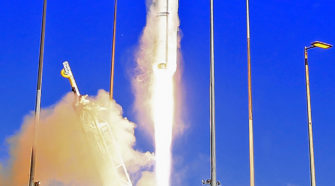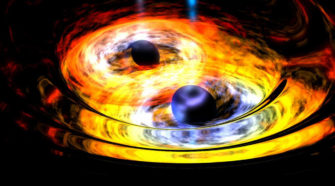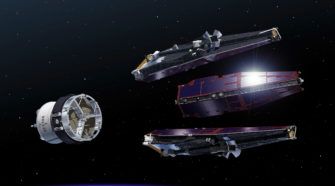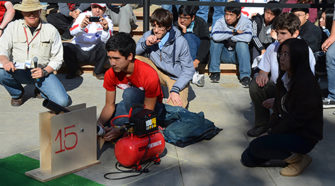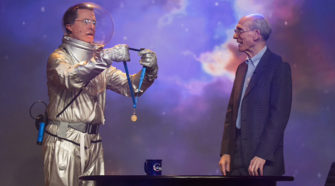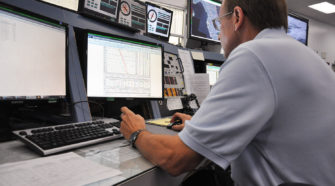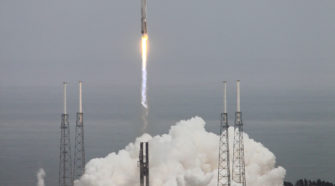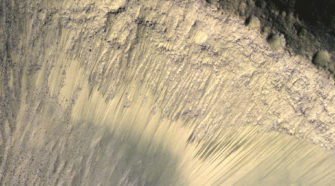Issue #5 (January 2014)
Cygnus delivers to the ISS
Orbital Sciences Corporation successfully launched their Cygnus spacecraft to the International Space Station on Jan. 9th. With freezing cold and clear blue skies as a backdrop the company sent Cygnus skyward atop their Antares rocket, which thundered away from the Mid-Atlantic Regional Spaceport launch Pad-0A at NASA’s Wallops Flight Facility in Virginia. The mission, Orb-1, …
WISE discovers black hole duo merging together
Two black holes are entwined in a gravitational tango in this artist’s conception. Supermassive black holes at the hearts of galaxies are thought to form through the merging of smaller, yet still massive black holes, such as the ones depicted here. NASA’s Wide-field Infrared Survey Explorer, or WISE, helped lead astronomers to what appears to …
ESA’s Swarm trio monitoring our planet’s magnetic shield
An artist view of the separation of the Swarm trio of orbiting satellites is pictured above. Credit: ESA/P. Carril ESA’s three-satellite Swarm constellation was lofted into a near-polar orbit by a Russian Rockot launcher in late November, 2013. For four years, it will monitor Earth’s magnetic field, from the depth of our planet’s core to …
Students ace ‘Hole-In-One’ contest at JPL
Students from 19 high school teams across Southern California, as well as NASA professionals, took part in a “Hole-in-One” contest in the Invention Challenge last month at NASA’s Jet Propulsion Laboratory, in Pasadena, Calif. The objective of the annual challenge was to create a device that could propel or move a golf ball into a …
China lands Yutu rover on the Moon
China scored a stunning, history making success with the successful touchdown of the ambitious Chang’e-3 probe with the ‘Yutu’ rover on the surface of the Moon Dec. 14, 2013, on the country’s first ever attempt to conduct a landing on an extraterrestrial body. The dramatic Chang’e-3 soft landing on the lava filled plains of the …
Stephen Colbert presents honor from NASA to Voyager scientist
As if NASA’s Voyager mission didn’t have enough firsts in its 36-year journey, what with sending the first spacecraft to Uranus, Neptune and, most recently, interstellar space! Now, it has another first back here on Earth: on the December 3, 2013 episode of the Colbert Report, host Stephen Colbert floated across the stage in a …
Keeping an eye on launch-day weather
Before MAVEN can study the atmosphere of Mars, it had to not only overcome Earth’s gravity but also make it through Earth’s atmosphere. Central Florida’s sometimes volatile weather can make launching rockets difficult. Weather is responsible for more than a third of launch delays and nearly half of the scrubs. The meteorologists of the 45th …
NASA’s MAVEN on way to Mars
NASA’s Mars Atmosphere and Volatile Evolution (MAVEN) space probe thundered to space on Nov. 18 following a flawless blastoff from Cape Canaveral Air Force Station’s Space Launch Complex 41 at 1:28 p.m. EST atop a powerful Atlas V 401 rocket. “Hey Guys we’re going to Mars!” gushed Bruce Jakosky, MAVEN’s Principal Investigator at a post …
India’s first Mars probe joins MAVEN in race to Red Planet
Indian space engineers initiated the 440 Newton liquid fueled engine firing precisely as planned during a critical nail-biting burn lasting some 22 minutes. The Trans Mars Insertion (TMI) firing propelled India’s Mars Orbiter Mission (MOM) away from Earth forever and placed the spacecraft on course for a rendezvous with the Red Planet on September 24, …
NASA Mars spacecraft reveals a more dynamic Red Planet
NASA’s Mars Reconnaissance Orbiter has revealed to scientists slender dark markings — possibly due to salty water – that advance seasonally down slopes surprisingly close to the Martian equator. “The equatorial surface region of Mars has been regarded as dry, free of liquid or frozen water, but we may need to rethink that,” said Alfred …

